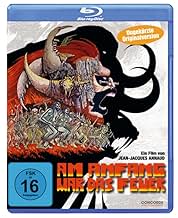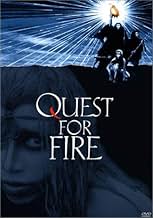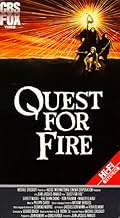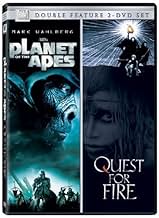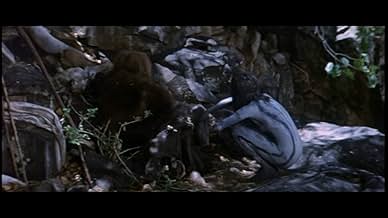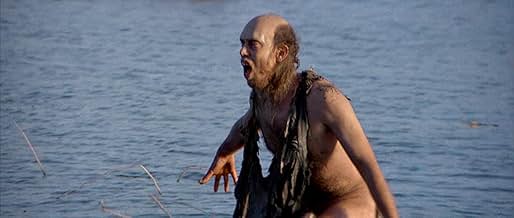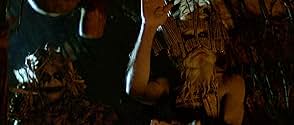Una storia che si svolge in l'epoca preistorica, quando tre membri della tribù cercano una nuova fonte di fuoco.Una storia che si svolge in l'epoca preistorica, quando tre membri della tribù cercano una nuova fonte di fuoco.Una storia che si svolge in l'epoca preistorica, quando tre membri della tribù cercano una nuova fonte di fuoco.
- Regia
- Sceneggiatura
- Star
- Vincitore di 1 Oscar
- 11 vittorie e 8 candidature totali
- Gaw
- (as Nameer El-Kadi)
- Aghoo - The Ulam Tribe
- (as Frank Olivier Bonnet)
- The Ulam Tribe
- (as Joy Boushell)
Recensioni in evidenza
Second, the story is universal: Every civilization on earth can pick up this film and understand it, because it goes to the most basic, primitive issues of a species (mainly, survival). Third, it makes the beginning of man interesting. Fourth, it reminds us we were once as savage as any other animal on earth.
Fifth, it's like no other movie you've seen before. That one I can guarantee you.
There's also that overlooked moment when Naoh humbly approaches the lordly herd of marauding mastodons. Tufts of grass in hand, he bows his head in an unmistakable gesture of submission, to which the herd responds-- not very plausibly --by chasing away the attacking cannibal clan. The point here is that Naoh understands in that quiet moment that we must live humbly with those forces much greater than ourselves if we want to survive-- a possible seed of what would later become religious belief, whether in the forces of nature or in the supposed power of the supernatural.
Of course, this is all speculation. The filmmakers don't exactly hit you over the head with their messages. However, the point is that the film succeeds admirably in getting you to think about the natural history of what these lowly but momentous origins must have been like. Moreover, there are other suggestive moments, such as when the camera transitions from Rae Dawn Chong's pregnant belly to the distant full moon and humanity's far-off future. Some reviewers point out scientific flaws in the script and reject the film on that basis. But that misses the point. Of course the film is not a documentary, so no serious researcher would base a study on it. Nonetheless, the movie remains just that, a well-staged and provocative ninety minutes of unusual filmmaking. I've seen nothing like it before or since.
In this film, facial gestures, hand movements, general body language and mannerisms of the characters are all consistent with conclusions about early man, as a result of thorough anthropological research. In lieu of modern language the film's dialogue consists of some 350 invented words and sounds, also based on research. In addition, an important part of the film is attention to detail in costumes and makeup, for which the film won several awards. All of these technical cinematic elements combine to create a reasonably accurate visual and audio impression of mankind as it existed some 80,000 years ago.
As you would expect, the film is shot entirely in rugged, remote locations, resulting in landscapes that are stunningly beautiful. Background music is generally low-key and ethereal, like what you might hear in a sci-fi film. There's lots of flute sounds, which reinforce the simplicity of the time period.
For all its technical achievements, this film's main weakness may be the screenplay. When you take away the artifacts of modern life, you're very limited in the kind of story you can tell. And that clearly is the case here, with a plot that drones on with a monotony and repetition that can be tedious, and at times difficult for some viewers.
Although the story's entertainment value may be marginal, "Quest For Fire", with its low tech cinematic style, is interesting not only for its technical elements but also for its over arching theme of modern human's continuity with prehistoric man, based on the element of fire.
Lo sapevi?
- QuizBoth Ron Perlman and Everett McGill suffered frostbite; luckily they were able to heal completely. Despite the working conditions, they both enjoyed making the film.
- BlooperThe movie is set 80,000 years ago, and appears to show the one tribe has made pottery. Fragments of ancient pottery found in southern China date back to only 20,000 years, making them the world's oldest known pottery. However, the vessel shown is actually a dried hollow gourd.
- Citazioni
[first lines]
Title Card: 80,000 years ago, man's survival in a vast uncharted land depended on the possession of fire. / For those early humans, fire was an object of great mystery, since no one had mastered its creation. Fire had to be stolen from nature, it had to be kept alive - sheltered from wind and rain, guarded from rival tribes. / Fire was a symbol of power and a means of survival. The tribe who possessed fire, possessed life.
- Versioni alternativeAll UK versions are cut by 8 secs and are missing a shot of a wolf on fire.
- ConnessioniFeatured in À propos de 'La guerre du feu' (1981)
I più visti
- How long is Quest for Fire?Powered by Alexa
Dettagli
- Data di uscita
- Paesi di origine
- Lingue
- Celebre anche come
- La guerra del fuego
- Luoghi delle riprese
- Aziende produttrici
- Vedi altri crediti dell’azienda su IMDbPro
Botteghino
- Budget
- 12.500.000 USD (previsto)
- Lordo Stati Uniti e Canada
- 20.959.585 USD
- Lordo in tutto il mondo
- 20.962.615 USD
- Tempo di esecuzione1 ora 40 minuti
- Colore
- Proporzioni
- 2.35 : 1
Contribuisci a questa pagina



![Bande-annonce [OV]](https://m.media-amazon.com/images/M/MV5BZTg3YWU0MTMtMDk1Mi00M2Y4LWFiODgtYzFhOTAyMWRjYWY2XkEyXkFqcGdeQXRyYW5zY29kZS13b3JrZmxvdw@@._V1_QL75_UY281_CR74)
